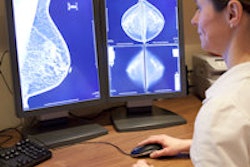
When women skip a mammography screening exam -- even for just one year -- their risk of late-stage cancer increases, according to a new study published in the November issue of the American Journal of Roentgenology.
These findings conflict with the revised 2009 mammography screening guidelines from the U.S. Preventive Services Task Force (USPSTF), which state that women should start screening mammography at age 50, rather than 40, and continue thereafter biennially through age 74, the authors wrote.
 Dr. Adedayo Onitilo from Marshfield Clinic Weston Center.
Dr. Adedayo Onitilo from Marshfield Clinic Weston Center.
Missed mammograms represent missed opportunities for earlier breast cancer diagnosis, according to lead author Dr. Adedayo Onitilo, from Marshfield Clinic Weston Center in Weston, WI, and colleagues.
"As a practicing oncologist, I see a lot of women who have never had mammography, and up to about 20% of them are younger than 45," Onitilo told AuntMinnie.com. "When they finally present for their first mammogram, they often have more-advanced disease."
For the study, Onitilo and colleagues parsed patient characteristics associated with missed mammograms and examined the association between the missed tests and breast cancer stage at diagnosis. They identified 1,428 women with breast cancer diagnosed between January 2002 and December 2008 (53 were eventually excluded, leaving 1,368 for analysis).
The researchers collected demographic and other information including the following:
- Number of medical encounters during the study period
- Insurance status
- Medical and family history
- Any mammograms within five years of breast cancer diagnosis
- Other cancer diagnoses
- Residence location
- Reasons for not undergoing mammography
Using mapping software, the team also estimated patients' travel time from their residence to the nearest mammography screening clinic (AJR, November 2013, Vol. 201:5, pp. 1057-1063).
Regardless of age, the women in the study cohort who had regular mammograms were more likely to have early-stage breast cancer at diagnosis, compared with those who did not undergo mammography, Onitilo's group found.
The difference between women who had undergone mammography screening and those who had not increased incrementally with each additional year: Those with no mammograms in the five years before breast cancer diagnosis had an 18% increase in late-stage disease at diagnosis. Put another way, more than 50% of the women included in the study with late-stage breast cancer missed five out of five annual mammograms before their disease was found.
Even one skipped year makes a difference, according to Onitilo and colleagues.
"Our results are in direct contradiction to the USPSTF guidelines," they wrote. "We found that even one year makes a significant difference in diagnosis of early- versus late-stage breast cancer. Women without a mammogram in the one year before a breast cancer diagnosis had a 12% increase in the risk of diagnosis of late-stage breast cancer compared with those who underwent annual mammography. This percentage difference was consistent in women older and younger than 50 years."
Why did women skip mammograms? The most common factors included not having a family history of breast cancer, fewer medical encounters of any kind, and increased travel time from home to the mammography center. (In fact, they found that each additional minute of travel time decreased the odds of a woman undergoing at least one mammographic examination in the five years before her cancer diagnosis.)
Primary care physicians can play a crucial role in encouraging women to get regular breast cancer screening -- and creative scheduling can help, too, the authors noted.
"[Patients] who must travel a greater distance for healthcare services, including mammography, may benefit from additional counseling or the opportunity to schedule screening mammography for the same day as an annual physical examination to avoid making multiple trips to the clinic," they wrote. "In addition, the annual physical should be used to emphasize the importance of annual mammography to women with no comorbid conditions, because this may be their only contact with the healthcare system throughout the year."
The complexity of factors that contribute to a woman skipping regular breast cancer screening exams suggests that guidelines such as the USPSTF's are not nuanced enough, according to Onitilo.
"When you're talking about individual patients, one size does not fit all," he told AuntMinnie.com. "Individual risk needs to be assessed, and screening protocols personalized."




















